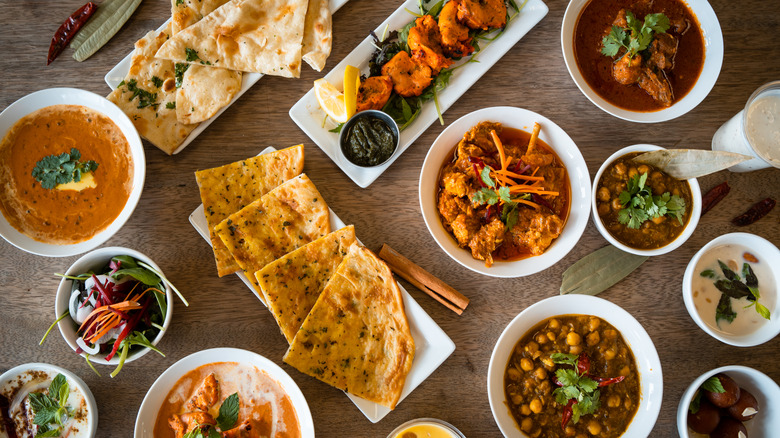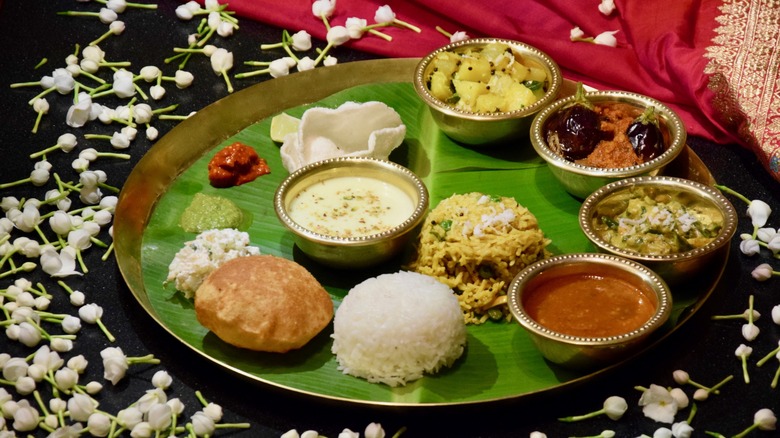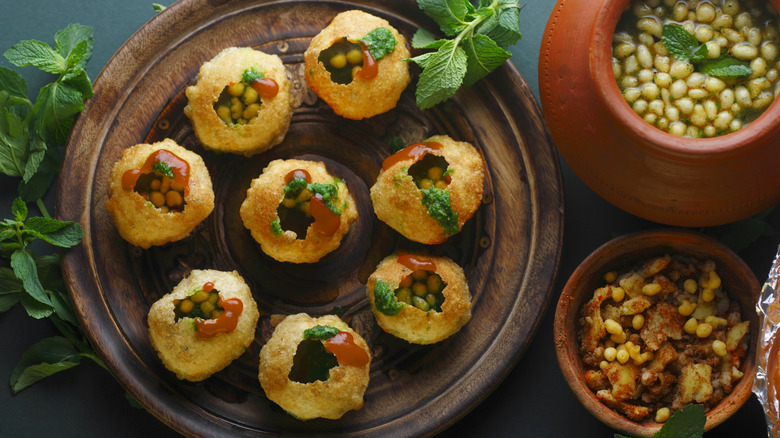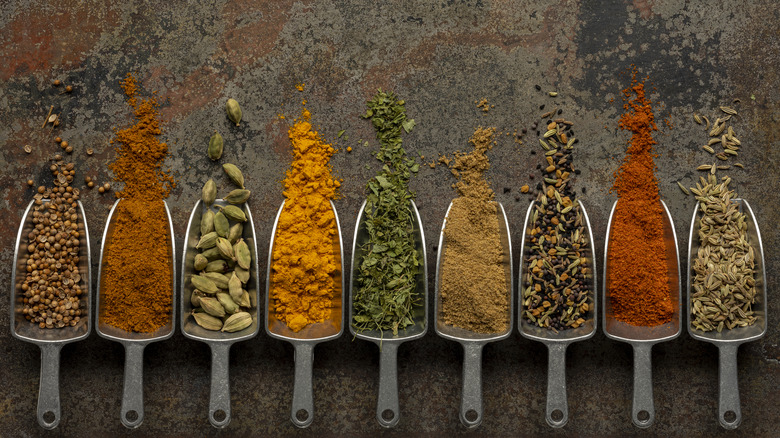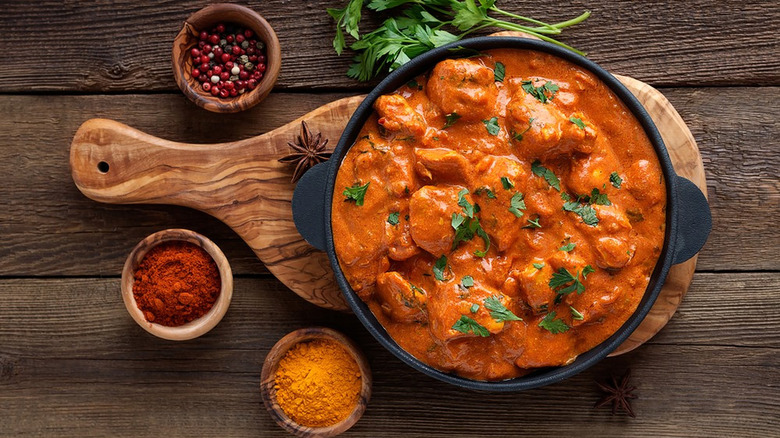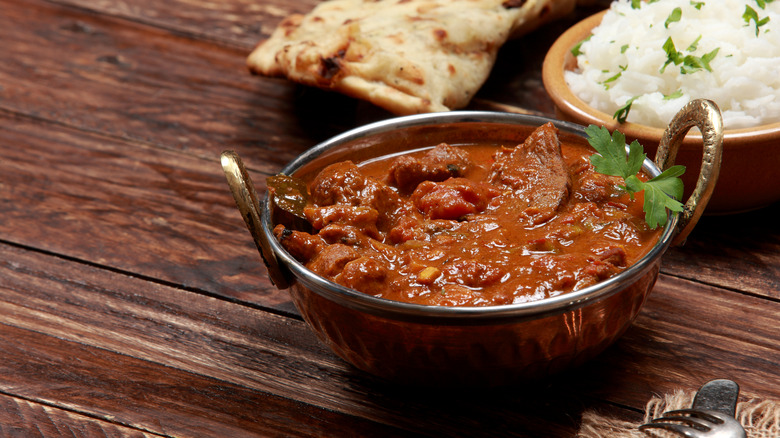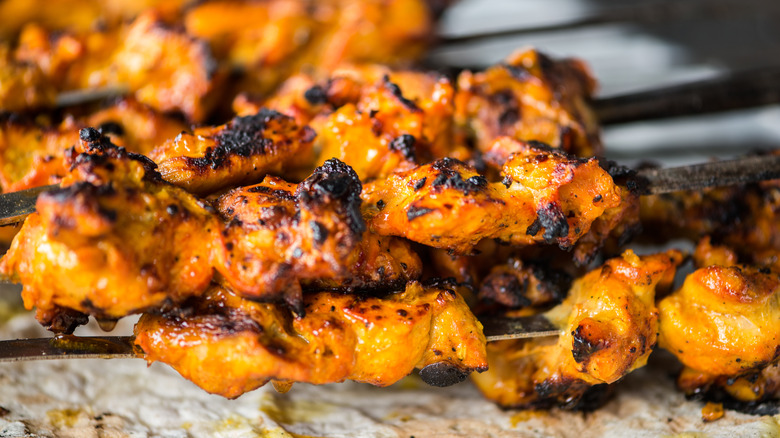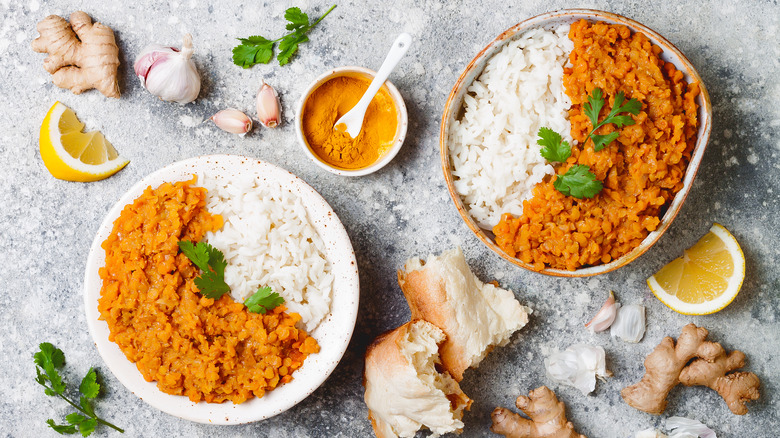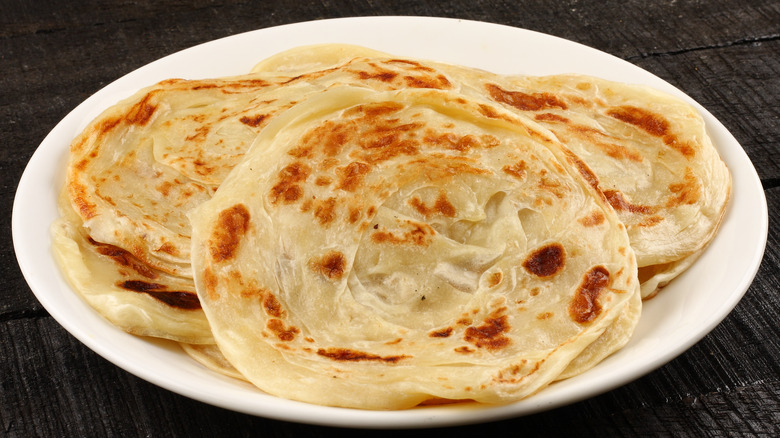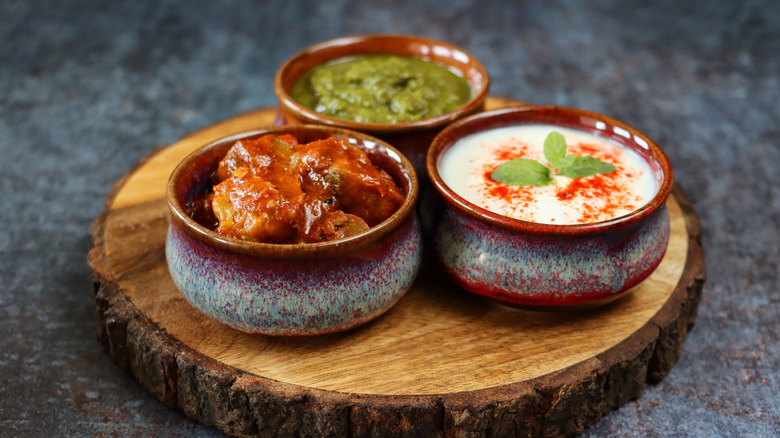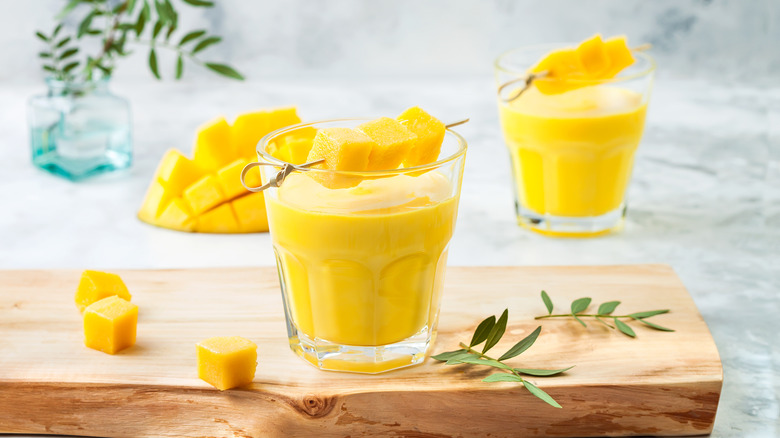36 Essential Words And Phrases To Know At An Indian Restaurant
If you're looking for a meal full of complex flavors and expertly combined spices, look no further than an Indian restaurant. From Northern India's palak paneer (fresh cheese stewed with spinach) to Goa's fiery vindaloo (vinegary curry with chilies) and central India's samosas, the ingredients, flavors, and cooking styles range dramatically across India's 1,269,299 square miles.
Enjoying an Indian meal is as simple as choosing a variety of dishes and sharing everything with your dining companions. Unlike Western restaurant meals, Indian cuisine is traditionally meant to be enjoyed with all the dishes on the table together, served family-style. Look for balance — in texture, temperature, heat level, and ingredients — to craft a meal full of complementary flavors.
There are so many Indian dishes you have to try, but the first step is understanding what is on the menu. Many menu words derive from Hindi, India's official language, and you'll spot some terms (like tikka, masala, or paneer) throughout the offerings. This list will help give you a basic understanding of cooking styles, must-know ingredients, and other menu basics, so you'll be on your way to ordering like a pro.
Indian cooking and serving styles: tandoor, kadai, thali
A tandoor is a rounded clay oven, essential to Indian cuisine. Traditional tandoors are built underground, with a narrow opening at surface level and a charcoal or wood fire burning at the wider base. In a restaurant setting, a tandoor is often a cylindrical metal oven with a ceramic lining that runs on gas or electricity.
Tandoors are used by a khansama, or male cook, to heat long skewers of meats and vegetables, as well as breads like naan, which are slapped against the side to bake. These ovens can reach temperatures of around 900 degrees Fahrenheit, quickly cooking breads and giving meats a signature char. Tandoori refers to this style of cooking, where skewered meats are grilled inside a tandoor for juicy, smoky results.
Whether you spell it kadai, karahi, or kadhai, this curved metal pan is a must-have in any Indian kitchen. It is similar to a wok, with a wide opening and high, curved sides, though a kadai has a flat bottom while a traditional Chinese wok does not. The shape of a kadai makes it incredibly versatile, great for deep-frying or simmering stews.
A thali is a wide, round plate or tray that holds a selection of small bowls called katoris, each filled with a different dish. Communal dining from a thali is a delicious staple of Indian restaurants, with all dishes served at once instead of in individual courses so everyone can mix and match flavors.
Indian snacks and street foods: chaat, pakoras, samosas, pani puri
India is famous for street foods and snacks, called chaat. These are perfect to tide you over before a meal, and take the place of appetizers at Indian restaurants. In Hindi, chaat means "to lick" or "to taste," a perfect name for these mouthwatering bites. One of their key components is chaat masala, or snack spice, a blend featuring dry mango powder, black salt, cumin, coriander, ginger, and asafoetida (dried resin from the roots of the ferula plant with a pungent aroma that adds a huge dose of umami). Bite-sized chaat offerings are usually fried and often contain chickpeas or potatoes.
Pakoras are deep-fried cakes, usually made of vegetables, held together by a batter — one of the best uses for garbanzo bean flour. Pakoras may be fritters of diced vegetables, or the veggies can be chopped into bigger pieces that are battered and fried.
Samosas are triangle-shaped pastries with vegetable or meat fillings, and can range from bite-sized to requiring a knife and fork. They're often served with a cilantro or mint chutney.
Pani puri is one of India's most beloved chaat varieties, a crispy, hollow shell with a mouthwatering filling. The shell itself is the puri, made with fine semolina into a dough that puffs into a hollow pastry when fried. Fillings include potatoes, lentils, and chickpeas — all topped with pani, a vibrant and flavorful sauce (pani means water in Hindi) that is sweet, spicy, savory, tangy, and fresh.
An Indian spice blend and cooking style: masala
Even if you've never been to an Indian restaurant before, you've likely heard of chicken tikka masala — but masala is more than that single dish. Masala is both a spice blend and a cooking preparation, and they're both essential to your Indian restaurant experience.
In Hindi and Urdu, masala refers to ingredients and spices. You'll see masala throughout the menu at an Indian restaurant, referring to dishes seasoned with a spice blend. Garam masala, for example, is a warming blend of ground spices (garam means hot in Hindi) like coriander, cardamom, cinnamon, cumin, cloves, peppercorns, and nutmeg — though homemade garam masala can be adjusted according to preference.
Chicken tikka masala is a much-beloved use of the fragrant and cozy spice blend, though this menu staple is believed to have origins in Scotland. It combines marinated chicken with a spiced tomato and cream sauce. You may also see dishes like chana masala (chickpeas in a curry sauce), masala dosas (a lentil pancake with a spiced potato filling), and aloo gobi masala (potatoes and cauliflower either seasoned with masala or in a masala curry sauce).
Chaat masala is a spice blend used on a variety of Indian appetizers, snacks, and street foods. It differs from garam masala with the use of more sour and tangy ingredients, like dry mango powder and ginger.
Indian curries: makhani, korma, madras
Curry essentially refers to gravy or sauce, and curries can be wet or dry (with no sauce, or a sauce that has been greatly reduced). Thinner curries are for eating with rice, while thicker curries are enjoyed by scooping them with pieces of bread. The spices depend on which dish is being made, and even curry leaves are not a staple — in fact, they are only used in recipes from the southern and western coasts of India (and not in Goa).
Makhani is a curry made with butter, cream, and tomato. The most popular iteration is murgh makhani, or butter chicken, which is credited as originating in the 1950s at Delhi's Moti Mahal restaurant. The difference between butter chicken and chicken tikka masala is the additional creaminess of the former's makhani curry, while tikka masala has more zest from its powerful spice profile.
Creamy korma is one of the mildest curry dishes, though if you have a nut allergy, you should skip this one. Korma is a yogurt- or cream-based sauce with a smooth texture that often comes from the inclusion of ground almonds or cashews. Korma is also a cooking style, where meats or vegetables are slowly braised to create a succulent and rich dish.
Madras curry is spicier and more earthy, with a notable use of paprika and coriander seeds. It has a deep, red hue from the chilies in the spice blend, and usually has a considerable amount of heat.
Indian spice combinations: bhuna, rogan josh, vindaloo
Unique combinations of spices give each curry its distinctive flavor, whether that's soothingly mild or vibrantly spicy. While yogurt, butter, and ground nuts give curries a creamy texture, skipping those ingredients or reducing the cooking liquid can allow the spice blends to really shine through.
Bhuna is a cooking technique with its name referring to the act of browning meat, which is essentially stir-fried with spices to create a thick and toasty paste that coats each bite. Bhuna is ideal for scooping up with a piece of naan.
Rogan josh is an intense, rich, heavily spiced dish that is often prepared with lamb, goat, or beef. The word rogan roughly translates to fat, while josh refers to heat. Rogan josh has a deep red color and a mild spiciness that is balanced with cardamom, coriander, and fennel. The red color comes from Kashmiri chilis, which are relatively mild, but are sought after for their vibrant hue. The meat is browned, and then the cooking liquid is reduced to create a thick and dark gravy, intensifying both the color and flavor.
Vindaloo is one of the most iconic — and spiciest — Indian curries, combining Goan and Portuguese influence in a fiery dish. The name refers to the use of vinegar and garlic (alho in Portuguese) in the recipe. Chilies that were contributed by the Portuguese centuries ago give the dish lots of heat, while vinegar adds a mouthwatering tang.
Indian meat preparations: tikka, kebabs, koftas
Indian restaurant menus include a variety of meat options and preparations. Knowing what each style is called will help you decode the menu and find your new favorite dish. Common meats on the menu at Indian restaurants include chicken, lamb, beef, and pork.
Tikka refers to cubes or small pieces of meat that have been marinated in spice-infused yogurt and roasted on skewers in a tandoor. This meat can be served on its own, or can be incorporated into a sauce, as in chicken tikka masala. The lactic acid in yogurt is more gentle than the acid in citrus or vinegar, so meats can be marinated longer in yogurt-based sauces — often overnight. This maintains the tender interior of the meat, providing a succulent contrast to the crispy char from tandoor cooking.
Indian kebabs are similar to tikka, with the meat being skewered before it is cooked. Some kebabs feature cubes of meat, while others are made with ground meat instead. Seekh kebabs, for example, are made with minced meat that is formed around thin skewers and cooked quickly over high heat.
Koftas are balls of spiced ground meat. These meatballs are often braised and then served in a curry, though they may also be skewered and grilled or roasted. Skewered kofta may also be called kofta kebabs. Koftas can also be made with vegetables, including malai kofta — a deep-fried dumpling commonly made with paneer cheese and potatoes.
Indian vegetarian specialties: paneer, dal
A huge number of Indians limit the amount of meat they consume, or refrain from eating it altogether — in large part because Hinduism considers cows to be sacred, while Islam forbids pork. As a result, hearty and flavorful plant-based dishes are easy to find at Indian restaurants.
Paneer is a fresh cheese that is a popular vegetarian source of protein. The cheese can be crumbled, or it can be pressed to create a thicker cheese that can be sliced and seared. Palak paneer (aka saag paneer) incorporates this cheese into spiced and stewed spinach, with the cheese often fried first to add a bit of texture. Paneer can also be used to make vegetarian dumplings, like malai kofta, or even be skewered and roasted in a tandoor as paneer tikka.
Dal — also spelled dahl or daal — can refer to a variety of dried lentils, peas, or beans. There are scores of dal varieties in India, but the most commonly used pulses are lentils. Dal also refers to a lentil curry, simmered until the pulses are soft before salt and spices are added. You will find dal in a large number of dishes, as it is a great source of protein for vegetarian diners. Dal makhani is made with butter and cream (à la butter chicken), while dal tadka is a hearty lentil soup. Another variety, chana dal, is made with split chickpeas.
Indian breads: naan, roti, paratha, dosas
Bread is the perfect accompaniment to an Indian meal. Yogurt-based breads can help temper fiery curries, while thinner flatbreads are an edible utensil to enjoy with dry dishes or chutneys.
Naan is a leavened bread made with white flour, which is cooked on the walls of the tandoor oven. The dough is rolled out, then slapped onto the wall of the tandoor to crisp on the bottom and bubble on top. Naan includes yeast and yogurt, which provide an airy structure and tender richness.
Roti, on the other hand, is unleavened bread made with whole wheat flour. The terms chapati and roti are used interchangeably when referring to this flatbread, though roti is often cooked over open fire with no oil, while chapati is always cooked in oil. Puri — as featured in pani puri chaat — is also made from wheat flour, though this bread is deep-fried so that it puffs up.
Paratha is a layered flatbread with butter or oil spread between layers of dough. It can be triangular, with a disk of dough brushed with oil and folded twice before cooking, or the dough can be rolled up, coiled into a snail shape, and rolled out again before cooking.
Dosas are a thin crepe-like bread made from a fermented batter of rice and lentils. This crispy pancake takes a day or two of advance preparation, as the batter needs time to ferment before cooking.
Indian sides and condiments: chutney, achar, raita, basmati, jeera, pilaf, biryani
Condiments and side dishes are a key part of Indian meals. They add heat, temper spice, and enhance flavor.
Chutney is a cooked or fresh dense sauce made from fruits, vegetables, or herbs, which can be coarse or smooth. Green chutney made with mint and cilantro is a slightly spicy dipping sauce for samosas. Tamarind is the tangy ingredient you should add to your next curry, and tamarind chutney both enhances and balances complex masalas. Achar is a pickled Indian condiment made with fruits and vegetables, which is used to add sharpness.
Another indispensable condiment is creamy raita, which is served alongside spicier dishes (although it's equally delicious when spread on naan). To make it, whipped yogurt is seasoned with salt, pepper, and spices, and raita can be enhanced with herbs and cucumber or other chopped vegetables.
Basmati is a long-grain rice grown in northern India, and when it is seasoned with cumin seeds, the result is jeera rice — a typical side dish at Indian restaurants. You might also see pilaf (also called pilau) on the menu. This rice is flavored with aromatics and often includes peas, almonds, and raisins. And while it's not a side, biryani is another basmati dish cooked with saffron, giving the rice its yellow hue. It is generally prepared by layering rice with meat, although vegetables or dried fruit can be added, before the pot is sealed to cook and steam before serving.
Indian drinks and desserts: lassi, chaas, chai, kulfi, falooda, gulab jamun
Any meal isn't complete without drinks and dessert. Round out your Indian restaurant experience with these must-try classics.
For a cool and refreshing drink, order lassi, a frothy yogurt drink that originated in Punjab. Sweet lassis include sugar and fruit, while salty varieties will also include spices like cardamom or cumin. Rose and mango lassis are popular. Fruit lassi is prepared similarly to smoothies, with fresh fruit blended into the yogurt. Another popular creamy drink is chaas (savory buttermilk or thinned yogurt with herbs and spices).
Chai is the Hindi word for tea, and if you order it at an Indian restaurant you'll likely be served masala chai, which is spiced. (Pro tip: Call it "chai" instead of "chai tea" — the latter is a redundant phrase for Hindi speakers.) This hot beverage combines black tea, spices (usually cardamom, ginger, cinnamon, clove, and star anise), milk, and sugar or jaggery (raw brown sugar).
Kulfi is a frozen custard you can't miss, which is similar to ice cream. This conical treat is made with milk that has been simmered, reduced, and slightly caramelized, then flavored with anything from pistachio to rose to mango. The base is not churned, and kulfi is more dense than ice cream. Another dessert is falooda, an ice cream-based treat made with milk, rose water, vermicelli noodles, basil seeds, and crushed nuts. Or, for something sticky, order gulab jamun — fried dough balls soaked in a sweet syrup.
